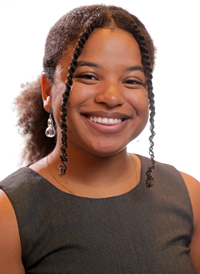Controlling Topological Defects in Curved Spherical Crystals of Hard Superballs
Gabrielle Jones, University of Michigan

Much like how a soccer ball cannot be manufactured solely with hexagonal patches, spherical particles that decorate the sphere surface cannot pack into a hexagonal lattice without disclinations. In physical systems such as Pickering emulsions, stabilized by the addition of colloids to the droplet interface, these disclinations and defect scars decorate the surface with icosahedral symmetry. Here we use hard particle Monte Carlo simulations to determine the effect of shape anisotropy and underlying lattice preference on defect structure and distribution on a closed sphere surface. Our analysis of cubic superballs demonstrate that cube particles form a simple square assembly, overcoming lattice/topology incompatibility, and minimize the free-energy by distributing eight three-fold disclinations evenly about the surface. Additionally, by varying particle superball shape smoothly from cubes to spheres we unveil how the global defect motif transitions from cubic to icosahedral symmetry. Congruent studies of tetrahedral superballs reveal additional varieties of motifs, such as simple square, honeycomb, and hexagonal. We additionally describe the differences in defect morphology for each packing motif. This work has promising implications for programmable defect generation for and access to different vesicle buckling modes such as those seen in icosahedral virus capsids.


